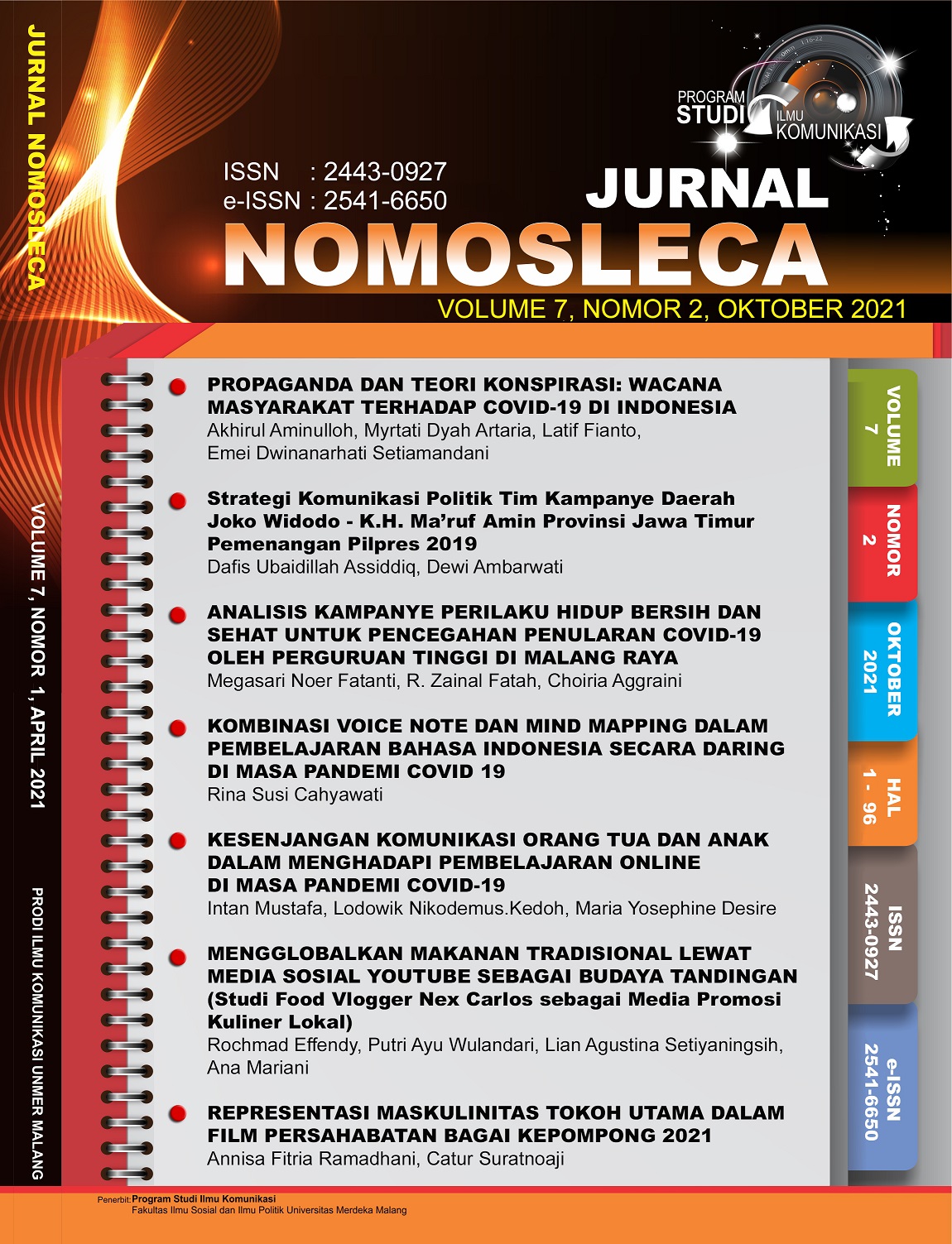Kombinasi Voice Note dan Mind Mapping dalam Pembelajaran Bahasa Indonesia secara Daring Masa Pandemi Covid-19
DOI:
https://doi.org/10.26905/nomosleca.v7i2.6050Abstract
Online  learning  is  one  of  the  alternative solutions set by the government in an effort to carry out an educational climate during the Covid-19 pandemic. Online learning patterns at least require teachers to try to find ways to make distance learning fun and can meet the needs of students for scientific material. The combination of voice notes and mind mapping is an alternative that can be used as a means and media for online learning. The assumption is that most of the participants currently have a WhatsApp application so that it will not make it difficult for them with regards to devices or quotas. Meanwhile, for making mind mapping students can make their versions according to their respective versions so that they will get the sensation of learning while playing. Therefore, the problems of this article are Indonesian language learning technical with a combination of voice notes and mind mapping; and strengths and weaknesses of the implementation of learning Indonesian with a combination of voice notes and mind mapping. The research method used is descriptive qualitative with content analysis. The result of the research is that a combination of voice notes and mind mapping can be used for learning Indonesian online by following the proper technical implementation. The combination of the two has a positive and negative impact on learning.
Â
Keywords: Voice Note, Mind Mapping, Indonesian Language Learning
Downloads
References
Abidah, A., Hidaayatullaah, H. N., Simamora, R. M., Fehabutar, D., & Mutakinati, L. (2020). The Impact of Covid-19 to Indonesian Education and Its Relation to the Philosophy of “Merdeka Belajar.†Studies in Philosophy of Science and Education, 1(1), 38–49. https://doi.org/https://doi.org/10.46627/sipose.v1i1.9
Areeisty, K., Hasanuddin, & Sarong, M. A. (2020). The implementation of problem-based learning with mind mapping to improve students’ learning motivation. Journal of Physics: Conference Series, 1460(1). https://doi.org/https://doi.org/10.1088/1742-6596/1460/1/012061
Dewanta, A. A. N. B. J. (2019). Pemanfaatan Aplikasi Tik Tok Sebagai Media Pembelajaran Bahasa Indonesia. Jurnal Pendidikan Dan Pembelajaran Bahasa Indonesia, 8(2), 5– 102.
Ering, M. (2020). Gereja Rumah di Masa Pandemi Covid-19: Manajemen Resiko dan Mitigasi Bencana Non Alam. Pute Waya: Sociology of Religion Journal, 10(1), 1-14.
Ernawati, I. R. (2020). Pendidikan dan Pembelajaran Bahasa Indonesia Online. Jurnal Pendidikan Dan Pembelajaran, 9(2), 103–112.
Fahmi, M. H. (2020). KOMUNIKASI SYNCHRONOUS DAN ASYNCHRONOUS DALAM E-LEARNING PADA MASA PANDEMIC COVID-19. Jurnal Nomosleca, 6(2), 146–158.
Handayani, E. S., & Subakti, H. (2020). Analisis Pembelajaran Daring Bahasa IndonesiaPada Masa Pandemi Covid-19 Di Sdn 027 Samarinda Ulu. Jurnal Basataka (JBT), 3(2), 81–89.
Juniartini, I. R. (2020). Pemanfaatan Aplikasi Google Meet Dalam Keterampilan Menyimak Dan Berbicara Untuk Pembelajaran Bahasa Pada Masa Pandemi Covid-19. Jurnal Pendidikan Dan Pembelajaran Bahasa Indonesia, 9(2), 133–141.
Kuncoro, I. (2015). PENGGUNAAN METODE MIND MAP DALAM PEMBELAJARAN BAHASA INDONESIA ASPEK MENULIS TEKS BERITA UNTUK MENINGKATKAN PRESTASI DAN MINAT BELAJAR SISWA KELAS VIIIB SMP NEGERI 3 KEBASEN (Vol. 2). SMPn 3 Kebasen.
Mahsun. (2014). Teks dalam Pembelajaran Bahasa Indonesia Kurikulum 2013 1st ed (1st ed.). Rajawali Pers.
Mandasari, Y. P., & Wulandari, E. (2021). Teaching ESP during emergency remote learning (ERL): Best practices. ELT Forum: Journal of English Language Teaching, 10(2), 154–162.
Meivi Sesanelvira, A. D. I., Mulyono, S., & S. (2019). Improving Food Safety Behavior through Mind Map Methods in School-Age Children. Comprehensive Child and Adolescent Nursing, 42(1), 97–107. https://doi.org/https://doi.org/10.1080/24694193.2019.1578301
Mustofa, M. A. (2020). Analisis Penggunaan WhatsApp Sebagai Media Pembelajaran Bahasa Arab di Era Industri 4.0. Arabiyatuna : Jurnal Bahasa Arab, 4(2), 333. https://doi.org/https://doi.org/10.29240/jba.v4i2.1805
Nilasari, K. E. (2020). Pembelajaran Bahasa Indonesia di masa pandemi di COVID 19. Paedagogia, 5(36), 27–39.
Nurazizah, H., Friatin, L. Y., & Sugiarto, B. R. (2019). Whatsapp Voice Note in Speaking Class. Journal of English Education and Teaching, 3(3), 343–360. https://doi.org/https://doi.org/10.33369/jeet.3.3.343-360
Nurhabibah, S. (2021). Penerapan Metode Mind Mapping Berbasis Daring Untuk Meningkatkan Hasil Belajar Mahasiswa PGSD di Masa Pandemi Covid-19. Jurnal Pendidikan Ilmu Sosial, 30(1), 13–22.
Purbasari, R. J. (2013). “Pengembangan Aplikasi Android Sebagai Media Pembelajaran Matematika Pada Materi Dimensi Tiga Untuk Siswa SMA Kelas Xâ€. Jurnal Pendidikan Matematika, 1(2).
Saharah, S., & Indihadi, D. (2019). PEDADIDAKTIKA: JURNAL ILMIAH PENDIDIKAN GURU SEKOLAH DASAR Penggunaan Teknik Mind Mapping pada Keterampilan Menulis Ringkasan Siswa dalam Pembelajaran Bahasa Indonesia. (Vol. 6, Issue 1). Jurnal UPI Education, 6(1). http://ejournal.upi.edu/index.php/pedadidaktika/index
Sahidillah, M. W., & Miftahurrisqi, P. (2019). Whatsapp sebagai Media Literasi Digital Siswa. Jurnal VARIDIKA, 1(1), 52–57. https://doi.org/https://doi.org/10.23917/varidika.v1i1.8904
Setiyaningsih, L. A., & Jatmikowati, S. H. (2019). Media Baru Dalam Komodifikasi Waktu Luang Ibu Rumah Tangga. ETTISAL: Journal of Communication, 4(1), 23–32.
Setiyaningsih, L. A. (2020). MEDIA PANICS IBU RUMAH TANGGA SETELAH MENGAKSES BERITA COVID-19 (2020). Jurnal Nomosleca, 6(2), 101–110. http://jurnal.unmer.ac.id/index.php/n/article/view/4721/2594
Setiyaningsih, L. A., Fahmi, M. H., & Molyo, P. D. (2021). Selective Exposure Media Sosial Pada Ibu dan Perilaku Anti Sosial Anak. Jurnal Komunikasi Nusantara, 3(1), 1–11. https://doi.org/10.33366/jkn.v3i1.65
Sugiyono. (2009). Metode Penelitian Kuantitatif, Kualitatif dan R and D. Penerbit Alfabeta.
Sulhin, I. (2020). COVID-19, PEMENJARAAN BERLEBIHAN, DAN POTENSI KATASTROFE KEMANUSIAAN. Jurnal Hukum & Pembangunan, 50(2), 400. https://doi.org/https://doi.org/10.21143/jhp.vol50.no2.2588
Susilowati, D. (2019). KEEFEKTIFAN METODE MIND MAPPING DALAM PEMBELAJARAN MENULIS TEKS BIOGRAFI. Jurnal Pendidikan Dan Pembelajaran Bahasa Indonesia, 8(2), 21–32.
Syawaludin, R., & Sutama, S. (2020). PENYUSUNAN PETA KONSEP MEMPERMUDAH BELAJAR SISWA SELAMA MASA PANDEMI COVID-19. Manajemen Pendidikan, 15(2), 89-98.
Triono, M. A., & Setiyaningsih, L. A. (2017). Desain Disonansi Kognitif Sebagai Faktor Anteseden Untuk Penguatan Kualitas Informasi Pada Website. Seminar Nasional Sistem Informasi, 1(1), 71–79. http://eprints.unmer.ac.id
Additional Files
Published
Issue
Section
License

This work is licensed under a Creative Commons Attribution-ShareAlike 4.0 International License.





